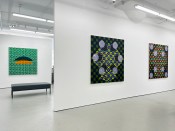On the occasion of “Heavy Light,” Nate Ethier’s second solo show at David Richard Gallery, Two Coats of Paint invited him to share ten ideas and influences that inform his complex, pulsating abstractions. He is keenly interested in kinetic motion, precision, and repetition, and credits Agnes Martin for the sense of happiness and innocence that suffuses his paintings. Most importantly, he reveals a penchant for close looking: “You can learn a great deal about light and color from a slow walk in the woods.” The show includes twelve stunning paintings and is on view through June 27.
Tag: David Richard Gallery
Joan Thorne, painter and artist
Contributed by Vittorio Colaizzi / Some painters insist on calling themselves painters rather than artists, and it’s clear why. “Art” designates is a broad category that admits almost anything, while painting is a tradition centered on a medium. In his recent book, Duchamp’s Telegram, Thierry de Duve argues that, while Marcel Duchamp did not single-handedly invent art in general, he perceived and announced its arrival. Before that, art was inconceivable outside the context of specific media such as painting, sculpture, and architecture. Duchamp’s insight, of course, did not spell the end of painting, Rather, it gave painters the option of retreating into self-sustaining insularity or more expansively embracing how painting and other art overlapped in terms of image, touch, plane, color, space, and voice. Joan Thorne, whose recent paintings are now on view at David Richard Gallery, has taken the latter course, to impressive effect.
Tony Robbin: Art and the cosmos
Contributed by Chunbum Park / Tony Robbin – a scientist and computer programmer as well as an artist – has spent decades pursuing fundamental questions of the cosmos and human existence. His visually enchanting work, currently on view in his solo exhibition “HyperSpace: Line, Color, Form, Pattern” at David Richard Gallery, appears non-representational. But if reality is not merely what is commonly observed at human scale but also what is observable at the quantum and cosmological levels, the distinction between representational, abstract, and nonrepresentational art can get murky.
Li Trincere in context
Contributed by Saul Ostrow / Seeing a selection of Li Trincere’s works from 1986–90 and 2020-21, I realized to review her show one would have to establish a context for her work. Thinking about that, I realized she is part of a lost generation of abstract painters, which consist of various groupings of artists working in styles rooted in the hard-edge, geometric tradition. What these artists have in common is they resist the industrial aesthetic of Pop and Minimalism.
Jeremy Gilbert-Rolfe: Speculations on abstract painting
Contributed by Saul Ostrow / Jeremy Gilbert-Rolfe has subtly set aside received truths about abstract painting, engaging it as a philosophical subject consisting of things which, regardless of differences of form and content, have been assigned the same classification.

























